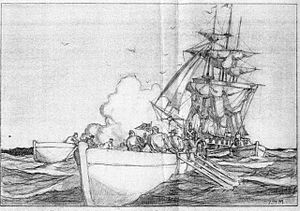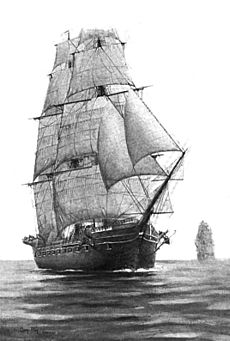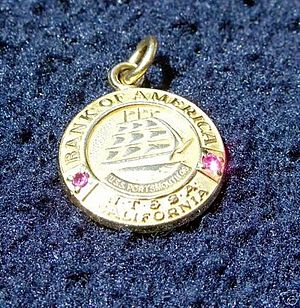USS Portsmouth (1843) facts for kids

USS Portsmouth in 1896 (John S. Johnston, photographer)
|
|
Quick facts for kids History |
|
|---|---|
| Name | USS Portsmouth |
| Builder | Portsmouth Navy Yard, its namesake navy yard |
| Launched | 23 October 1843 |
| Commissioned | 10 November 1844 |
| Decommissioned | 14 July 1878 |
| Stricken | 17 April 1915 |
| Fate | Sold, and destroyed, 6–7 September 1915 |
| General characteristics | |
| Type | Sloop-of-war |
| Tonnage | 1,022 |
| Length | 151 ft 10 in (46.28 m) |
| Beam | 37 ft 3 in (11.35 m) |
| Draft | 16 ft 6 in (5.03 m) |
| Propulsion | Sail |
| Complement | 200 Naval officers and enlisted, 27 Marines |
| Armament |
|
The USS Portsmouth was a wooden sloop-of-war, a type of warship with sails, used by the United States Navy in the mid-to-late 1800s. It was the second ship to be named Portsmouth. This ship was designed by Josiah Barker and built at the Portsmouth Naval Shipyard in New Hampshire. The Portsmouth was launched on October 23, 1843, and began its service on November 10, 1844. Commander John Berrien Montgomery was its first captain.
The Portsmouth's Adventures: A Timeline
Serving in the Mexican–American War (1845–1848)
The Portsmouth played a big part in the Mexican–American War. On January 25, 1845, it sailed from Norfolk, Virginia, all the way around Cape Horn (the southern tip of South America). Its mission was to join the Pacific Squadron, a group of naval ships, led by Commodore John D. Sloat.
Along the way, the ship stopped in places like Rio de Janeiro and the Hawaiian Islands. When it reached the coast of California, its job was to watch British ships. This was to make sure Great Britain didn't try to take over the area if the U.S. and Mexico went to war.

After the U.S. declared war on Mexico, something important happened. On July 9, 1846, a group of Marines from the Portsmouth went ashore. They marched to the main square of a town called Yerba Buena (which is now San Francisco). There, they raised the American flag, taking control of the city. This square is now known as Portsmouth Square in modern Chinatown.
The Portsmouth stayed in San Francisco Bay until November 1846. Then, it was sent to San Diego. In 1847, under Captain Montgomery, the ship helped block Mexico's west coast. It joined other ships to bombard the city of Guaymas. After the city surrendered, a group of soldiers went ashore to occupy it. By early 1848, its mission was complete, and the ship sailed back to the U.S. east coast.
Patrolling the West African Coast (1848–1851)
After returning to Boston in May 1848, the Portsmouth soon sailed east again. It went to the coast of Africa. From August 1848 to February 1849, it patrolled with ships from the Royal Navy (Britain's navy). Their important job was to stop the slave trade. The ship returned to this duty between September 1849 and May 1851, finally coming back to Boston in June 1851.
Adventures in the Pacific and Africa (1851–1861)
Six months later, the Portsmouth left Boston for duty in the Pacific Ocean. In April 1855, it returned to the east coast for repairs. On May 3, 1856, it set sail for the Pacific again.
Under Commander Andrew H. Foote, the ship reached Batavia (in Indonesia) 94 days later. From there, it sailed to China. In November 1856, it took part in a fight against the Barrier Forts near Canton. These forts were protecting the city. The ship was ordered home in January 1858 and stayed in Portsmouth, New Hampshire, for a while. It then sailed for Africa again for another three-year tour from 1859 to 1861.
Serving in the Civil War (1861–1865)
When the American Civil War began, the Portsmouth was prepared for war between September and December 1861. It then sailed to the Gulf of Mexico. There, it joined the Union blockade, which was a naval effort to stop supplies from reaching the Southern states.
By February 1862, the ship had caught two "blockade runners" off Texas. These were ships trying to sneak past the blockade. In April, the Portsmouth helped in attacks against Forts Jackson and Fort St. Philip. From May 1862 to August 1865, it served as a station ship in New Orleans. This meant it was a permanent ship in that port.
Later Years: South America and Pacific (1865–1878)
After the war, the Portsmouth continued its busy career.
- From 1866 to 1867, it was a quarantine vessel in New York. This meant it helped check ships for diseases.
- From 1869 to 1871, it cruised off Brazil and Africa.
- In early 1872, it carried new crew members to Brazil.
- From 1873 to 1874, it helped with survey missions in the eastern Pacific. This included a stop at the Palmyra Atoll in December 1873. The ship's doctor, William H. Jones, studied the animals and plants there and made a detailed map.
- In 1875, it cruised off the west coast of Latin America.
On July 14, 1878, the Portsmouth was officially taken out of service as a warship. It was then used as a training ship for young boys learning to be sailors. An amazing act of bravery happened on July 25, 1876. A sailor named Alexander Parker tried to save a shipmate from drowning. For this, he later received the Medal of Honor.
Training Ship and Final Days (1878–1915)
In 1878, the Portsmouth returned to the east coast. It arrived in Washington, D.C. in February. In March, it sailed to France, returning in December. It continued its training duties from January 17, 1895. First, it trained naval apprentices, then members of the New Jersey Naval Militia, until March 1911.
During this time, three more crew members earned the Medal of Honor for saving fellow sailors from drowning:
- Francis Moore on January 23, 1882.
- Henry C. Courtney and Thomas Cramen on February 7, 1882.
After its training duties, the Portsmouth was loaned to the United States Public Health Service. It served as a boarding launch at a quarantine station in Charleston, South Carolina. On April 17, 1915, the ship was removed from the Naval Vessel Register (the official list of Navy ships) and later sold.
The Portsmouth was taken to Governors Island in Boston Harbor. On the night of September 6–7, 1915, it was burned as part of a carnival event in South Boston. Many politicians and people watched as flames came out of its empty gun ports, and a fireboat siren saluted its end.
The Portsmouth's Legacy
Bank of America Logo
The Portsmouth ship was chosen as the logo for the Bank of America. The bank's founder, Amadeo Giannini, picked it to honor the ship's role in securing San Francisco. Service pins given to bank employees even show the ship's image and its name.
The ship's steering wheel, called a helm, was taken off when the ship was decommissioned. In 1995, it was on display in the reception area of the bank's headquarters.
Hoboken Civil War Memorial
The Portsmouth was part of the New Jersey Naval Militia in the early 1900s. Two large guns from the ship, called Dahlgren guns, are now part of the Hoboken Civil War Memorial. This memorial is located at Stevens Park in Hoboken, New Jersey.




